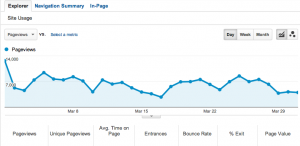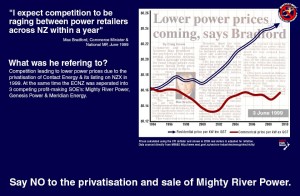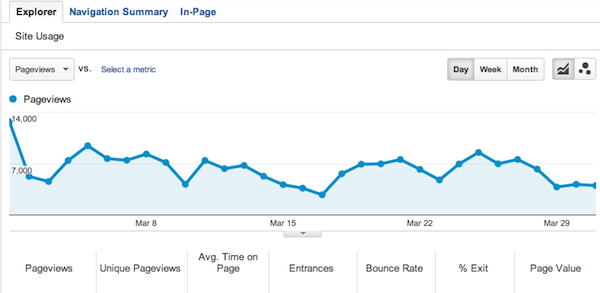Welcome to higher electricity prices suckers!
Face TV listings Tuesday 2nd April
AM
7.00 Aljazeera News
8.00 In Focus
8.45 Classic serial
9.00 Bloomberg
10.00 Green Matters
10.30 Tomorrow Today
11.00 euronews
PM
12.00pm In Conversation
12.30 Bloomberg
1.00 TV Chile 24 Horas
1.30 euronews
2.00 NHK Newsline
2.30 Korean news
3.00 Dutch news
3.30 French news
4.00 German news
4.30 Box Office America
5.00 Euromaxx
5.30 DW Journal
6.00 Aljazeera News
7.00 Pacific Viewpoint
7.30 The Beatson Interview
8.00 The Couch [PGR]
9.00 Australia News
9.30 The Wine Squad [PG]
10.00 Danger Man [PG]
10.30 PBS News Hour
11.30 Song Writers Across Australia
Face TV broadcasts on Sky 89 & Auckland UHF
Face TV Twitter
Face TV Facebook
Some Stats + Top 20 The Daily Blog Posts For The Month
 As Martyn Bradbury announced yesterday, The Daily Blog has soared from an audience of zero at 9am March 1 to attracting 84,213 visits by midnight March 31. And this audience has accessed 196,886 pages pushing this new site up into 5th position on the Open Parachute blog-ratings.
As Martyn Bradbury announced yesterday, The Daily Blog has soared from an audience of zero at 9am March 1 to attracting 84,213 visits by midnight March 31. And this audience has accessed 196,886 pages pushing this new site up into 5th position on the Open Parachute blog-ratings.
From a communication strategy angle, what is particularly pleasing is how 85.04% of this traffic is located within New Zealand. I’d like to think the other 14.6% is made up of Kiwis who live abroad.
For those who consider deeper traffic analysis, The Daily Blog ends its first month with 56% returning visitors and 43.28% new visitors. It has an average visit duration of 3 minutes 23 seconds and a pages-read-per-visit ratio of 2.34. Its bounce rate for the month is 59.82%.
Without crowing too loudly, the Google Analytics statistics (cited above) reveal a phenomenal ride and offer The Daily Blog writers and commentator community a solid foundation to build upon.
If you want to follow April’s traffic performance, check out The Daily Blog’s SiteMeter realtime and prediction ratings.
After initial discussions in 2012, in January 2013 we set out to construct a site that could deliver and sustain anticipated high-audience-growth. We sought to present a secure site with a design that gave navigational priority to daily posts while offering easy access to sections and the site’s writing talent, displaying a chronology of their specialist posts.
The goal was also to provide an opportunity for a progressive thinking community to develop that was prepared to debate the issues and not fall foul of personality assassinations.
Like life, The Daily Blog is a project in development. From a design angle; thank you to Chris Trotter and all of you who have made suggestions on how we can improve your experience (Chris’ idea was to create the lead-post section on the front page). We’ve made some improvements, and we have a few tweaks yet to make. Do continue to tell us what you would like to see on The Daily Blog.
From a personal angle, what is most satisfying after one month is seeing how The Daily Blog commentators have begun, what we had hoped – create for themselves a real sense of community around the works of some of New Zealand’s top writers. Indeed the commentators on The Daily Blog have shown how deep is New Zealand’s pool of progressive thinkers. And the writing talent… well check them out here. Know too that we have some innovative community-engagement/debate ideas in development that we have yet to put before you. It is exciting and we think by creating some innovative debating opportunities for The Daily Blog community these initiatives will continue to ensure this site becomes even more valuable to you and your communities.
On that point, if you have not registered, you can do so here, and we will keep you posted.
But for now, and in celebration of the debut month, check out the Top 20 Posts for March 2013 and do read the commentators’ responses and analyses of the issues:
- TDB Top 20 Posts (March 2013, based on page views)
1: John Minto’s Peter Jackson, mental fragility, employees and contractors – Page Views: 4,725
2: Marama Davidson’s “Annette Sykes is a stupid person” says Judith Collins – Page Views: 3,547
3: Coley Tangerina’s This is no country for women – Page Views: 2,355
4: Queen Of Thorns’ Rape culture: we’re living in it – Page Views: 2,057
5: Selwyn Manning’s Rudderless Within The Great Game – Page Views: 1,922
6: Martyn Bradbury’s Latest allegation of Police bashings – Page Views: 1,817
7: Martyn Bradbury’s The leaps and bounds of Patrick Gower – how the spin is spun – Page Views: 1,753
8: Dr Wayne Hope’s Debunking the Holmes mythology – Page Views: 1,579
9: Martyn Bradbury’s Susan ‘I’m not racist but’ Devoy – Page Views: 1,533
10: Laila Harré’s Laila Harré goes all the way (WARNING: Politically explicit) – Page Views: 1,502
11: Martyn Bradbury’s When can Pakeha celebrate Waitangi Day? A response to Dame Susan Devoy – Page Views: 1,454
12: Martyn Bradbury’s How left wing are our left wing politicians? – Page Views: 1,349
13: Lynn Prentice’s Pete George – an example of right wing blogging falsehoods – Page Views: 1,330
14: Chris Trotter’s The Opportunity Cost Of David Shearer – Page Views: 1,233
15: Chris Trotter’s Welcome To The Wasteland – Page Views: 1,233
16: Steve Gray’s Full Disclosure OR Do You Know Where That Journalist Has Been? – Page Views: 1,208
17: Chris Trotter’s With God On Their Side: Explaining Labour’s Factional Divisions – Page Views: 1,205
18: Martyn Bradbury’s Greg Boyed fat shames two women via twitter – happy international women’s day – Page Views: 1,156
19: Chris Trotter’s Hell And High Water – the National Party agenda to seize water – Page Views: 1,144
20: Martyn Bradbury’s Welcome to The Daily Blog – now with Laila Harre – Page Views: 1,139.
Proverbs you won’t read on Whaleoil
“The man who loves his king, will forever be a slave.”
The Daily Blog first month stats
When I started this idea of bringing together the best left wing and progressive opinion shapers all onto one blog to gain momentum in the lead up to next years election, my wildest ambition was that we could debut with a 100 000 page view month.
The stats are in and we have exceeded my wildest ambition. The Daily Blog in its debut month achieved 196886 page views! The appetite online to hear the other side of the story is larger than I had hoped. The incredible talent of the bloggers and writers who make visiting this site daily such delight must be thanked alongside Selwyn Manning’s great design.
The stats will see us debut on the NZ blog rankings at 5, knocking Throng off its perch. Taking Throng down a peg pleases me no end, I’ve never understood how a TV review site can be so right wing AND love every broadcasting crime NZ on Air puts money into.
The Daily Blog’s focus is to bring some real debate to the NZ Blogossphere and to provide an alternative to the far right online nonsense of Kiwiblogh, Wailoil and ultimately the exceedingly biased corporate media.
Our debut is confirmation that we are off to a great start. Thank you for reading and thank you for returning each day.
We have further announcements on May 1st of more bloggers and Unions joining.
Cheers
Lying For The Revolution: John Roughan Defends Neoliberalism
YOU CAN ALWAYS TELL when an ideology is dying – it starts lying.
In its early years a world-changing ideology relies on facts. It points to our lived experience of reality and asks: “Does this still work for you?” It has no need to falsify or distort: to the contrary, the more truth it speaks the more persuasive it becomes.
This was Neoliberalism in the late-1970s and 80s. The western world was on an inflationary treadmill. Prices were rising relentlessly and wages were following them up – but always with a little lag – with the result that, year by year, the actual purchasing power of people’s wages and salaries was falling.
As if this steady erosion of people’s incomes wasn’t bad enough, unemployment and inflation seemed to be linked. The newspapers called the combination of stagnating employment growth and runaway inflation “stagflation”. It was, they said, proof positive that the hitherto highly successful post-war policy of full employment – based on the economic theories of John Maynard Keynes – was failing.
According to Keynes, the State could keep everyone in work by spending large sums on goods and services calculated to soak up excess labour and stimulate demand. This expenditure was funded out of progressive taxation and from money the State would effectively borrow from itself .
Keynesianism’s critics argued that “excessive” government spending, by expanding the money supply, was simply sending too many dollars in pursuit of too few goods – the classic definition of inflation. Even worse, in its effort to create jobs, the State was “crowding out” productive investment in the private sector, leading to business-failures and job losses. In short, by attempting to create jobs, the State was, paradoxically, destroying them.
The Neoliberals’ prescription was simple, and to most people it sounded like plain common-sense. To rein-in inflation and reduce unemployment all a government had to do was: stop printing money; cut state spending; and give the private sector its head.
As the economy adjusted itself to this new “economic rationalism”, warned the Neoliberals, people would, unfortunately, be required to endure a little short-term pain. But they would definitely gain in the long-term. The private-sector was inherently more efficient than the State and was, therefore, ideally placed to guarantee all those who wanted them real jobs, at good wages, without inflation.
AS WELL ALL NOW KNOW, there was a little more to the Neoliberal prescription than that. And one man, the Polish economist, Michal Kalecki, had seen it all coming thirty-five years before it actually happened.
In an article entitled “The Political Aspects of Full Employment”, published in The Political Quarterly of October 1943, Kalecki wrote:
“The maintenance of full employment would cause social and political changes which would give a new impetus to the opposition of the business leaders. Indeed, under a regime of permanent full employment, the ‘sack’ would cease to play its role as a ‘disciplinary’ measure. The social position of the boss would be undermined, and the self-assurance and class-consciousness of the working class would grow. Strikes for wage increases and improvements in conditions of work would create political tension. It is true that profits would be higher under a regime of full employment than they are on the average under laissez-faire, and even the rise in wage rates resulting from the stronger bargaining power of the workers is less likely to reduce profits than to increase prices, and thus adversely affects only the rentier interests. But ‘discipline in the factories’ and ‘political stability’ are more appreciated than profits by business leaders. Their class instinct tells them that lasting full employment is unsound from their point of view, and that unemployment is an integral part of the ‘normal’ capitalist system.”
The loss of “discipline in the factories” – that was the real reason employers were so determined to rid themselves of Keynesianism. Under its full-employment policies there may have been some short-term gains (if you can call thirty years of unprecedented prosperity and growth “short term”) but in the long-term Keynesianism posed a deadly threat.
If allowed to go unchecked the power and confidence the State’s interventions had secured for working people would inevitably see it move beyond the provision of education, health and welfare services and into sectors of the economy where its enterprises would be competing directly with those of the private sector. To a limited extent this had already happened in the energy and transportation sectors. What would be next? Manufacturing? Retail? Finance?
For capitalists, the impetus which Keynesian full-employment policies gave to post-war social-democracy was frightening. In a sellers’ market for labour, trade unions had become a dangerous locus of economic, social and political power. The influence this afforded them in the political parties to which they were aligned was, by the early 1970s, seriously eroding the power of the top one percent of income earners. If the economic and social logic of full-employment advanced even a little bit further, the position of the capitalist elites would become untenable.
Something had to be done – and that something was Neoliberalism.
WITH THE PASSAGE of thirty years, it has become very clear (even to those who initially bought into Neoliberalism’s 1980s sales-pitch) that its promises of long-term gain were just another variant of “There’ll be pie in the sky when you die.”
The promised pain, on the other hand, has been all-too-real. A vast gulf of wealth and power now yawns between the beneficiaries of the Neoliberal “revolution” and its victims. The average working-class New Zealander is more indebted, earns less in real terms, feels more vulnerable in the workplace and is less secure economically than at any time since the Great Depression.
That being the case, it becomes extremely important for Neoliberal apologists to reassure the people upon whose political support Neoliberalism relies that the whole exercise has been a rip-roaring success.
Unfortunately for these apologists they can no longer use people’s lived reality to make the case for them. There is simply no way the conditions of the pre-Neoliberal era can be honestly presented as worse than those of the present. From the purchasing power of the average weekly wage to the lack of affordable housing for young families, the conditions of life for ordinary New Zealanders under Neoliberalism have got worse – not better.
As a consequence, Neoliberal apologists are forced to falsify the past: to create a narrative that unequivocally inverts historical reality.
This falsification of the past, in order to justify the ways of Neoliberalism to Man, has no more energetic champion than the New Zealand Herald columnist, John Roughan. In the paper’s Saturday’s edition (30/3/13) he calls for the closure of the Tiwai Point aluminium smelter – evoking, in justification, a quite extraordinarily tendentious, and just plain wrong, version of this country’s post-war history:
Acknowledging that “one or two” of his relatives have enjoyed “a lifetime of employment” at Tiwai, he concedes a debt of gratitude to the National Government of the 1960s for its decision to “turn hydroelectricity into aluminium ingots”.
“It might have been a good idea”, says Mr Roughan, “if the price of electricity had been right – the price we have never been allowed to know.
“The price of most things at that time was controlled or subsidised and nobody knew or cared that prices didn’t align the item’s cost of production to its value in a competitive market. The economy was a job-creation scheme that ended with double-digit unemployment in the 1970s.”
This is an outrageous falsification.
At no time during the 1970s did unemployment ever climb above 2 percent of the workforce. The highest unemployment total of the decade was recorded in 1979 when just under 25,000 people – out of a workforce of 1.3 million – were registered as unemployed. (Source: New Zealand Official Yearbook, Department of Statistics, 1983) In the year ended December 1974, the number of people registered as unemployed in New Zealand had numbered less than a thousand!
Of course Mr Roughan has no choice but to turn the 1970s into an unmitigated economic failure. To do otherwise would call into question the wisdom and efficacy of the entire Neoliberal Revolution. After all, the only time since the Great Depression when unemployment exceeded 10 percent of the New Zealand workforce was 1991 – the year of National’s arch-Neoliberal Finance Minister, Ruth Richardson’s “Mother of All Budgets”.
The extent to which Mr Roughan has succumbed to Neoliberalism’s absurd mythology is revealed in the next passage of his column. Here he compares Keynesianism to a steam-engine and Neoliberalism to an automobile!
“It was then that governments everywhere learned elementary economics. They realised an economy was not a steam engine that you stoked with as much money, labour, land and fuel that you could lay your hands on. It was more like an automobile that operated best for those inside it when the engine was tuned with precision.
The best method of tuning it, economists said, was a market price. A price set by competition and consumer choice would give each cog in the engine as much fuel, capital, labour and other resources it could efficiently use, and tell you which industries would boost the country’s wealth.”
Clearly those responsible for the Global Financial Crisis: all those expert auto-mechanics at Lehman brothers, Merrill Lynch, Fannie Mae, Freddie Mac, Washington Mutual, Wachovia, Citigroup and AIG were not at work the day those cogs and wheels ground themselves into piles of useless junk? A mess which only the despised State’s capacity to borrow from itself was big enough to clean up.
It is rare to encounter Neoliberal self-delusion on such an all-encompassing scale as Mr Roughan’s. Such egregious historical distortion should make us all very angry, but it can also, in a curious way, comfort us. What it reveals is an ideology entering the twilight of it reign: a system requiring only a few solid blows to send it crashing down.
When a revolution can only be defended by lies, then it’s no longer a revolution.
Vigilance on web civil liberties needed
The Law Commission continued its review of new media this week with their release of the report The News Media Meets ‘New Media’: Rights, Responsibilities and Regulation in the Digital Age. Commissioned by Judith Collins, the report continues the government’s investigations into how the new media environment needs to be legislated in New Zealand.
The backdrop of its release has been read against the Leveson Inquiry in the UK, which in its examination of hacking scandals looked for sometime to extend press regulations to bloggers (thus opening up political bloggers to potential libel cases and detracting from freedom of speech) and the Finkelston Inquiry. This has meant that the reception of the Law Commission’s recommendations to establish one single regulatory body and self-regulates has been received as largely positive. Some commentators have drawn attention to the way that the Law Commission intends to incentivize this, by only allocating special privileges to the media or bloggers that join. This may have the effect of meaning that it is only people who make money off the web have the financial ability to join, therefore excluding the smaller players.
The report argues that new media and traditional media boundaries are becoming fluid in a way that makes it difficult to uphold the law. The Law Commission overestimate the blend between ‘old’ and ‘new’ media in both reports, going so far to say that it is not uncommon for broadcasters to follow message boards on TradeMe in the cyberbullying report. As convergence guru Henry Jenkins argues in his work Convergence Culture: when old and new media collide (2006), the premise that the new media forms will completely replace older models of broadcasting is a utopian ideal that guided earlier discussions of the net and is largely outdated now. What we are seeing is new partnerships where old and new media exist in symbiosis. The idea that newspapers will completely become redundant then, is not entirely true, while they are currently challenged with adapting to the drop in advertising revenue due to declining print circulation, it is likely that there will be an ongoing demand for the kind of regular news that organized broadcasters provide (and bloggers are dependent on).
However, the most interesting part of the report lurking in the Law Commission’s recommendations is that the current report should be read alongside their August 2012 Harmful Digital Communications report into cyberbullying in terms of the legal extensions into the online environment. The report into cyberbullying is focused on the concerns of teens and other individuals growing up in the digital environment, and how people are exposed to increased harassment that they are unable to counter. Online harassment is a serious issue in many countries, and the report argues for an emphasis on education around digital footprints, setting privacy settings, and a general emphasis on civil civic engagement online. But it is here where the debate gets interesting and a lot more murky.
In the previous report, the Law Commission recommends that there is up to a $2000 fine for bloggers and vexatious comments on blogs. While this might sound reasonable for extreme cases, the report argues that there needs to be a great deal of education in the blogging community as to what constitutes offence, making it seem like this barrel of laws could be open to future abuse. They also signal Twitter out as a potential area for further legislation (signaling that perhaps they haven’t seen the daily banter of politicians on Twitter – the debate can get quite fierce). The two reports together signal problems for journalists who tweet, as individual comments could open up their organizations to potential fines. The fines on blogging and on commenters on blogs would exist outside of the new media organization being set up. The Commission wants a Communications Commission set up, that processes complaints quickly, but where the accused has no right to protest the decision or represent themselves, a structure which signals that it could potentially be up for abuse. The previous report also signals a desire to legislate beyond the regulatory convergence that has largely dictated the internet, and a desire to eventually submit Facebook and Google to state laws. While in some cases state pressure has been positive on these organizations, such as Germany’s concerns around privacy on Facebook, in others it has led to the shutting down of political freedom (for example Saudi Arabia, Bahrain, London’s legislation to shut down the net after the riots, and so on). While New Zealand is unlikely to come down this hard on people, it is really important to ensure that we do not open up the internet for cases that could potentially shut down internet freedom and as TechLiberty highlight, this particular series of reports could be potentially open to abuse.
Face TV listings Monday 1st April
AM
7.00 Aljazeera News
8.00 In Focus
8.45 Classic serial
9.00 Bloomberg
10.00 Popxport/Kino
10.30 Wellbeing A-Z
11.00 euronews
PM
12.00pm Let’s Talk
12.30 T News
1.00 TV Chile 24 Horas
1.30 euronews
2.00 NHK Newsline
2.30 Korean news
3.00 Dutch news
3.30 French news
4.00 German news
4.30 J-Melo
5.00 Euromaxx
5.30 DW Journal
6.00 Aljazeera News
7.00 In Conversation
7.30 Treasures of the World
7.45 Gay Talk TV [PG]
8.00 Eat, Play & Stay
8.30 Outside the Square [PG]
9.00 Australia News
9.30 Classic Film Club: Scott of the Antarctic (1948) [PG]
11.30 Hitchcock season: Blackmail (1929) [AO]
Face TV broadcasts on Sky 89 & Auckland UHF
Face TV Twitter
Face TV Facebook
Sometimes it’s an embarrassment to be a New Zealander
Just how spineless a government can be in the face of corporate bullying was on show last Thursday as State Owned Enterprise Minister Tony Ryall announced the government was stepping in with the offer of more subsidies for the Rio Tinto aluminium smelter at Tiwai point in Southand.
Ryall’s commitment came after negotiations between the smelter and Meridian Energy failed to reach agreement over the company’s demand for even cheaper electricity.
Meridian chief executive Mark Binns said just the day before that “there remains a major gap between us on number of issues, such that we believe that it is unlikely a new agreement can be reached”.
With Rio Tinto threatening to close the smelter in rushed Ryall with bagloads of our money to placate this largest of corporate bullies.
Rio Tinto wants to renegotiate with Meridian because it says the world price for aluminium has dropped and it could close the smelter unless we agree to an even cheaper price for electricity than it already enjoys, courtesy of other New Zealand electricity users – you and me.
It knows it has the government over a barrel because John Key is determined to privatize our electricity sector. However if the smelter closes the price of electricity will drop dramatically (the smelter uses over 14% of our electricity supply) and the government’s flagship sale of Mighty River Power would be a disastrous flop.
To keep this house of cards standing the government will cave in to Rio Tinto. Instead of spine we will see the political equivalent of gelatinous cartilage.
Even the government knows the Rio Tinto posturing is corporate opportunism. Ryall admitted this saying “they’re pretty tough negotiators and I’m sure they look at what else is happening in the economy when they make their various decisions”.
The “what else is happening in the economy” is the sale of Mighty River Power.
The government should call Rio Tinto’s bluff and tell them to bugger off. The company claims to make a contribution of around $1 billion to the New Zealand economy but an independent financial analysis shows the real figure is closer to $200 million.
In fact we’d probably be better off as a country if the government closed the smelter and paid the current smelter workers their salaries for the rest of their lives. That’s how bad this corporate junkie is addicted to taxpayer subsidies. But instead of cutting the dependency cord the government is widening it with more taxpayer sustenance.
CAFCA (Campaign Against Foreign Control of Aotearoa) has described the Rio Tinto situation as “the textbook example of corporate welfare in New Zealand.”
Rio Tinto won the 2011 Roger Award for the worst foreign multi-national company operating in New Zealand. At the time the company was using bullying threats to close the smelter if the Emissions Trading Scheme came into force. The judges’ report at the time concluded the company had a 50-year history of “suborning, blackmailing and conning successive New Zealand governments into paying massive subsidies on the smelter’s electricity; dodging tax, and running a brilliantly effective PR machine to present a friendly, socially responsible and thoroughly green-washed face to the media and the public.”
Whether its Warner Brothers, Skycity or Rio Tinto we have our gutless government pumping taxpayer money hand over fist into corporate coffers.
It’s another embarrassing week to be a New Zealander.
Corporate Welfare under National
.
.
In case there are still one or two New Zealanders remaining who haven’t yet cottoned on to one very simple truism about National in office, let me spell it out; they are rank hypocites of the highest order.
And in case you, the reader, happen to be a true-blue National supporter, let me explain why.
In the last four years, National has been beavering away,
- slashing budgets
- sacking nearly 3,000 state sector workers
- closing schools
- attempting to close special-needs services such as Nelson’s Salisbury school
- cutting state services such as DoC, Housing NZ, Police, etc
- freezing wages for state sector workers (whilst politician’s salaries continue to rise)
- cutting back on funding to various community services (eg; Rape Crisis ands Women’s Refuge)
- and all manner of other cuts to state services – mostly done quietly and with minimum public/media attention.
In return, the Nats successfuly bribed us with our own money, giving us tax-cuts in 2009 and 2010. (Tax cuts which, later, were revealed not to be as affordable as what Dear Leader Key and Little Leader English made out – see: Key: $30b deficit won’t stop Nats tax cuts, see: Government’s 2010 tax cuts costing $2 billion and counting)
One such denial of funding for public services is an on-going dispute between PHARMAC and the New Zealand Organisation for Rare Disorders (NZORD) which is struggling desperately to obtain funding for rare disorders such as Pompe’s Disease,
.
Acknowledgement: Fairfax Media – Mum not prepared to wait and die
.
NZORD and it’s members have been lobbying National for the last four years to gain funding for much-needed medication. They are in a dire situation – this is a matter of life or death for them.
This blogger has blogged previously about their plight,
Previous related blogposts
- Priorities? (19 Oct 2011)
- Terminal disease sufferer appeals to John Key (12 Nov 2012)
- “There’s always an issue of money but we can find money for the right projects” – John Key (20 Jan 2013)
- “One should judge a society by how it looks after the sick and vulnerable” – part tahi (4 March 2013)
- “One should judge a society by how it looks after the sick and vulnerable” – part rua (4 March 2013)
- “One should judge a society by how it looks after the sick and vulnerable” – part toru (4 March 2013)
This blogger has also written directly to the Prime Minister and to Health Minister, Tony Ryall.
One response from Minister Ryall is presented here, for the reader’s attention,
.
.
So there we have it, folks. If you’re a New Zealander dying from a rare disease, and PHARMAC won’t fund life-saving medication – don’t expect an assistance from this rotten government. Their response will be, and I quote,
“While I share your concern [snort!!!] for people with Pompe disease, as I advised you in my letter of 22 November 2012, in the current fiscal environment, unfortunately funding is not available for all treatments.”
So “in the current fiscal environment, unfortunately funding is not available for all treatments“?!
But funding is available for;
$1 Rugby – $200 million to subsidise the Rugby World Cup (see: Blowouts push public Rugby World Cup spending well over $200m)
$2 Movies – $67 million paid to Warner Bros to keep “The Hobbit” in New Zealand (see: The Hobbit: should we have paid?) and $300 million in subsidies for “The Lord of the Rings” (see: Hobbit ‘better deal than Lord of the Rings’ – Key)
$3 Consultants – After sacking almost 3,000 state sector workers (see: 555 jobs gone from public sector) – and with more to come at DoC – National seems unphased at clocking up a mind-boggling $1 billion paid to “consultants”. (see: Govt depts clock up $1bn in consultant fees)
And on top of that, we are now faced with the prospect of a trans-national corporate – Rio Tinto – with their hands firmly around Meridian Energy’s neck, attempting to extract a greater subsidy from the SOE powerco. The story began in August last year,
.
Acknowledgement: NZ Herald – Rio Tinto seeks power deal revision
.
We know why. Despite implausible assertions to the contrary by National Ministers, Genesis Energy, and Rio Tinto executives – the partial sale of SOE powercos (Meridian, Genesis, and Mighty River Power) have made them vulnerable to the demands of Big Businesses.
Rio Tinto knows that the share price of each SOE will be predicated on marketplace demand for shares.
They know that if there is less demand for electricity, then the price of power may (note: may) drop; those SOE’s profits will drop; and the price of shares will drop.
That leaves shareholders out of pocket and National with egg on it’s face. And a whole bunch of Very Pissed Off Voters/Shareholders.
Think: Warner Bros. Think: corporate blackmail to shift ‘The Hobbit’ overseas. Think: National not wanting to risk the wrath of Peter Jackson and a thoroughly manipulated Public Opinion. Think: National looking at the 2011 election. Think: panic amongst National ministers and back-room Party strategists.
National capitulated.
This is precisely what is happening with Rio Tinto, Meridian, and National.
In the space of six and a half hours yesterday (28 March 2013), events came to a dramatic head. The following happened in one day:
9.15am:
Via a Press Release from Merdian Energy;
“Thursday, 28 March 2013, 9:15 am
Press Release: Meridian EnergyNew Zealand Aluminium Smelter’s electricity contract
For immediate release: Thursday, 28 March 2013
Meridian was approached by Pacific Aluminium, a business unit of global mining giant Rio Tinto Ltd, the majority shareholder of New Zealand Aluminium Smelters Ltd (NZAS), in July 2012, to discuss potential changes to its existing electricity contract.
Since talks began, various options have been discussed and Meridian has offered a number of changes and concessions to the existing contract.
Chief Executive of Meridian Energy, Mark Binns, says that Meridian has advised Pacific Aluminium of its ‘bottom line’ position.
“Despite significant effort by both parties there remains a major gap between us on a number of issues, such that we believe that it is unlikely a new agreement can be reached with Pacific Aluminium,” says Mr Binns.
In the event no agreement can be reached, Meridian will seek to engage with Rio Tinto and Sumitomo Chemical Company Ltd, the shareholders of NZAS, who will ultimately decide on the future of the smelter.
Meridian signed a new contract with NZAS in 2007, after three years of negotiations. This current contract commenced on 1 January 2013 and remains unaltered and binding on the parties.” – Source
To which Rio Tinto replied,
10.15am:
In a NZ Herald story,
CEO of Pacific Aluminium (the New Zealand subsidiary of Rio Tinto), Sandeep Biswas responded with,
“We believe a commercial agreement that is in the best interests of NZAS, Meridian, the New Zealand Government, and the people of Southland can be reached. We look forward to continuing productive negotiations with a view to achieving a positive outcome for all parties.” – Source
De-coding: “This ain’t over till the Fat Chick sings, and she’s nowhere to be seen. You guys better start hearing what we’re saying or this is going to turn to sh*t real fast; we’ll close our operations at Bluff; 3,200 people employed by us directly or indirectly will be told ‘Don’t Come Monday’; your Southland economy will collapse like a Cyprus bank, and National can kiss goodbye to it’s re-election in 2014. Ya got that, sunshine?”
11.15am:
That got the attention of National’s ministers Real Quick,
The Government has opened discussions with Tiwai Point aluminium smelter’s ultimate owners Rio Tinto in a bid to broker a deal after talks between the smelter and Meridian Energy reportedly broke down.
[…]
“With this in mind, the Government has been in contact with Pacific Aluminium’s international parent company Rio Tinto this week to discuss helping to bridge the gap in their positions over the short to medium term, if this could be of assistance in concluding an agreement.
“In the meantime, we understand Meridian’s existing contract with Pacific Aluminium remains in place at least until 1 January 2016 with significant financial and other obligations beyond that.” – Source
Barely two hours had passed since Meridian had lobbed a live grenade into National’s state asset sale programme, and it’s fair to say that the Ninth Floor of the Beehive was in a state of panic. It was ‘battle stations’. Red Alert. National ministers were, shall we say, slightly flustered,
.

.
12.00pm:
By noon, the markets were reacting. Though share-market analysts were attempting to down-play the so-called ‘Phoney War’ between Meridian and Rio Tinto, Devon Funds Management analyst, Phillip Anderson, remarked that,
“…the announcement had hit Contact’s share price – the company was down 3 per cent in early trading but is now down only 1.2 per cent.” – Source
If Contact’s (a fully privatised ex-SOE) share price had dropped 3% on the strength of these media stories, it is little wonder that share-market analysts were down-playing the brinkmanship being played out by Meridian and Rio Tinto. If the share-market was spooked enough, Contact’s share price would plummet, as would that of Mighty River Power – estimated to be in the $2.36 and $2.75 price-range. (see: Mighty River share tips $2.36 to $2.75).
In which case, National would be floating shares worth only a fraction of what ministers were seeking. In effect, if Rio Tinto closed down operations, Key could kiss goodbye to the partial sale of energy SOEs. They would be worthless to investors.
3.43pm:
By 3.43pm, and six and a half hours since Meridian’s press release, National had negotiated some kind secret deal with Rio Tinto. We don’t know the terms of the deal because though it is our money, National ministers don’t think we have a right to the information,
The Government is negotiating a new taxpayer-funded subsidy with Tiwai Point aluminium smelter’s owners and has all but acknowledged its assets sales programme is being used by them to get a better deal on power prices.
State Owned Enterprises Minster Tony Ryall this morning said the Government has opened discussions with the smelter’s ultimate owners global mining giant Rio Tinto in a bid to broker a deal over a variation to the existing electricity contract.
[…]
“With this in mind, the Government has been in contact with Pacific Aluminium’s international parent company Rio Tinto this week to discuss helping to bridge the gap in their positions over the short to medium term, if this could be of assistance in concluding an agreement.”
Mr Ryall indicated the Government had offered Rio Tinto “a modest amount of money to try and help bridge that gap in the short to medium term but there’s still a very big gap in the long term… We’re not interested in subsidising this business in the long term”. – Source
Ryall added,
“…they’re pretty tough negotiators and I’m sure they look at what else is happening in the economy when they make their various decisions…
…”they certainly haven’t got the Government over a barrel.”
Three questions stand out from Ryall’s statement,
- If State subsidies for electricity supply to Rio Tinto’s smelter are “short to medium term” – then what will happen when (if?) those subsidies are lifted? Will shareholders “take a bath” as share prices collapse in value?
- Does Ryall think we are fools when he states that Rio Tinto did not have the government “over a barrel” ?! Is that how National views the public – as morons?
- How much is the “a modest amount of money” that Ryall is referring to?
Perhaps the most asinine comment from Ryall was this, as reported by TVNZ,
“The electricity market is capable of dealing with all the issues relating to the smelter,” said Ryall.
Acknowledgement: TVNZ News – Talks break down over Tiwai smelter contract
Really?! In what way is “the electricity market … capable of dealing with all the issues relating to the smelter” when the government has to step in with what could be millions of dollars worth of subsidies? Is that how “the market” works?!
This blogger has two further questions to put to Minister Ryall. Both of which have been emailed to him,
.
Date: Thu, 29 March 2013, 6.43pm
From: Frank Macskasy <fmacskasy@yahoo.com>
Subject: Re: Your correspondence to Hon Tony Ryall
To: Tony Ryall <Tony.Ryall@parliament.govt.nz>Kia ora, Mr Ryall,
I am in receipt of your emailed letter to me, dated 5 December 2012, regarding the non-funding of certain medications for sufferers of Pompe Disease. Firstly, thank you for taking the time to respond to this issue in a thorough and timely way. Several of your other ministerial colleagues seem to lack that simple etiquette.
I note that, as Minister of SOEs, you have been in direct negotiations with Rio Rinto, and have offered the company subsidised electricity for the “short to medium term”.
This will no doubt cost the taxpayer several millions (hundreds of millions?) of dollars.If National is able to provide such largesse to a multi-national corporation, please advise me as to the following;
1. Why is the same subsidy for cheaper electricity not offered to ALL New Zealanders? Or even those on low-fixed incomes? Why provide a multi-million dollar subsidy just to a billion-dollar corporation when New Zealanders could do with a similar cut in their power bills?
2. In your letter to me, dated 5 December 2012, you point out that,
“While I share your concern for people with Pompe disease, as I advised you in my letter of 22 November 2012, in the current fiscal environment, unfortunately funding is not available for all treatments.”If National has millions of dollars available to subsidise multi-national corporations, them obviously your statement on 5 December 2012 that “in the current fiscal environment, unfortunately funding is not available for all treatments” – is simply not credible.
It is obvious that your government can find money when it wants to. This applies to Rugby World Cup funding, consultants, movie-making subsidies, etc.
As such, I hope you are able to find the necessary funding for medication for people suffering rare disorders.
You are, after all, Minister for Health as well as Minister for State Owned Enterprises.
Regards,
-Frank Macskasy
BloggerPS: Please note that this issue will be canvassed further on the blogsite, The Daily Blog.
.
Minister of Health. Minister for SOEs. Minister for corporate welfare.
Which ‘hat’ will Tony Ryall be wearing today?
And will he find the necessary funding to save the lives of sick New Zealanders?
.
*
.
References
NZ Herald: Rio Tinto seeks power deal revision (10 Aug 2012)
Scoop.co.nz: New Zealand Aluminium Smelter’s electricity contract Press Release (9.15am, 28 March 2013)
NZ Herald: Govt steps in to sort out stalled Tiwai power deal (11.15am, 28 March 2013)
NZ Herald: Tiwai stoush may affect Mighty River price (12.00pm, 28 March 2013)
NZ Herald: Govt offser Tiwai subsidy (3.43pm, 28 March 2013)
Related references
NZ Herald: Mighty River share tips $2.36 to $2.75 (20 March 2013)
Related to previous blogposts
Pharmac: The politics of playing god (16 June 2011)
$500,000 a year to keep toddler alive (5 Feb 2013)
Rare disease sufferers want pricey treatments (1 March 2013)
Rare disease takes awful toll on boy (1 March 2013)
Call for an Orphan drugs access policy to overcome Pharmac’s systems failure (28 Feb 2013)
Bill English – do you remember Colin Morrison? (4 Feb 2013)
Related Opinion
NZ Herald – Fran O’Sullivan – Govt intervention doesn’t cut mustard (30 March 2013)
.
.
= fs =


























